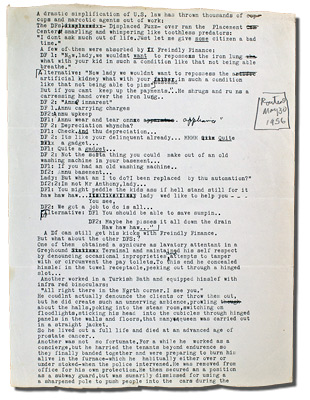 |
 |
|||||||||||

Typescript draft of "Displaced Fuzz," dated in Allen Ginsberg's hand, May 30, 1956. Later published in Interzone. An example of Burroughs' early routines written in Tangier, often in the form of a letter to Allen Ginsberg—epistolary fiction that would culminate in the creation of Naked Lunch.
Typescript draft, circa mid-1950s, with sections that would find their way into Naked Lunch. Burroughs was beginning his experiments with non-linear narrative, combining various vignettes that could be read in any order. Burroughs would venture into the further abstraction of cut-ups and fold-ins at the decade's end. VIEW DETAIL
Holograph dream notes with drawing titled, "The Blind Mouth," circa mid-1950s. Dreams were an important wellspring for Burroughs' creative process. This stray ephemeral page is an antecedent to the more elaborate dream/collage journals of the 1960s. VIEW DETAIL

"Brief History of the Occupation/Cut." Typescript draft, circa 1960. Over 20 pages of "word horde" cut-ups. The creative collaboration with Brion Gysin pushed Burroughs further into an experimental process of assemblage, disassemblage and reassemblage of his writing.

Heavily annotated manuscript, circa 1963. Likely written during the period when Burroughs was working with Anthony Balch on the cut-up film Towers Open Fire. Burroughs made extensive use of film, photographs, tape recordings and newspaper articles for his cut-ups.
Typed manuscript, circa mid-1960s. A lengthy draft of cut-ups, most of which is unpublished. Fragments can be found in the US edition of The Ticket That Exploded, and in the stories "Last Post Danger Ahead" and "A Distant Hand Lifted," published in The Burroughs Files anthology. VIEW DETAIL

Cut-ups/fold-ins, dated 1966. Six separate pieces typed on ledger paper. Themes include the Mayan calendar, Adam & Eve & a hog, and LSD. In the mid-1960s, Burroughs was producing short pieces for the small circulation art & literature magazines of the mimeo revolution.

"Electricals," typed draft, circa late 1960s. This draft is annotated as being overflow of material from The Wild Boys. "Electricals" was eventually published in 1973 in Exterminator!.
Dream Journal, 1968. A large notebook of dream notes written in red, blue and green ink. Dream subjects include Paul Bowles, Samuel Beckett, Hoagy Carmichael and the CIA. Burroughs increasingly incorporated dream material, which provided a spontaneous and subversive element in his fiction. VIEW DETAIL

"Red Desert and Lizard Boy." Typescript drafts together with cut-ups in an envelope, circa 1973. Burroughs' use of cut-ups waned in the early 1970s as he returned to the more linear narrative of the Red Night Trilogy. The archive contains two more of these later cut-up stories, "Alaska & Dahlfar" and "Red Boy & Port City," all unpublished.
"Carsons Family," typed drafts, circa 1973. Over 90 pages of what appears to be the start of a new book exploring the family of Burroughs' protagonist, Audrey Carsons. This material serves as a literary bridge between Port of Saints and Cities of the Red Night. While almost all of the "Carsons Family" material is unpublished, one long description of Burroughs' childhood on Pershing Avenue in St. Louis was used for the opening of Cobblestone Gardens, published in 1976. VIEW DETAIL

Doctor Benway manuscript and publisher's archive, 1979. The famous routine from Naked Lunch was reworked by Burroughs for publication as a limited edition in 1979. Present are Burroughs' typescript, the production art and contracts.
© 2011 Ken Lopez Bookseller